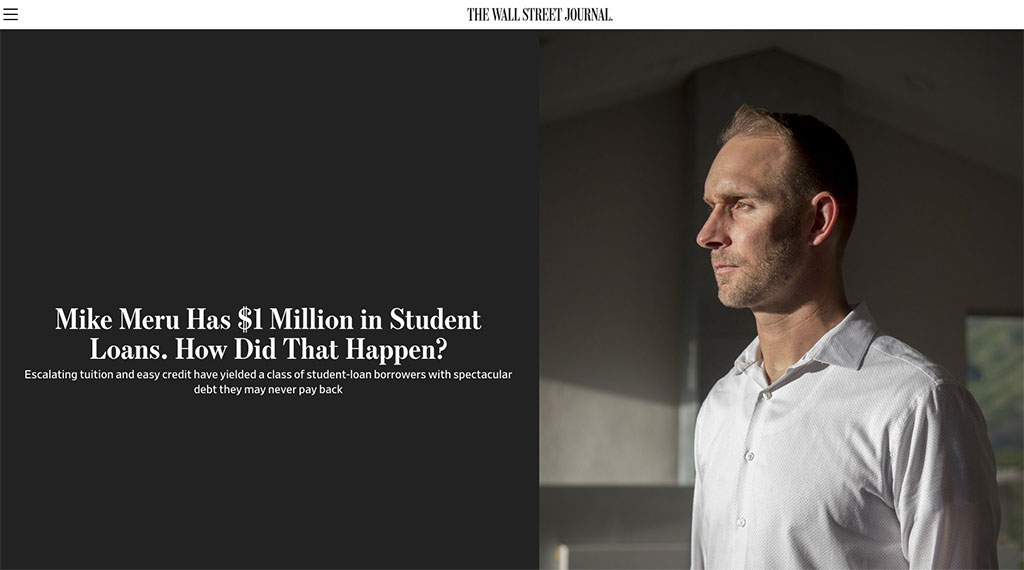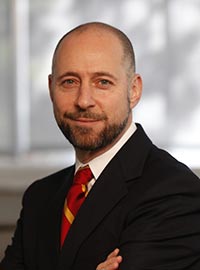
Profile of Dr. Mike Meru in The Wall Street Journal
By Maxwell Rotbart
A recent story featured prominently in The Wall Street Journal highlighted the plight of one dentist who has accrued more than $1 million in student loan debt - with very little possibility of ever repaying it.
The culprit the Journal explained is the high cost of dental school tuition and rising student loan interest rates.
Journalist Josh Mitchell, an economics reporter in the paper’s D.C. bureau, wrote that Utah orthodontist Mike Meru is one more than 100 people in the United States who owe at least $1 million in federal student loans.
While the typical student borrower owes $17,000, data from the Education Department show that roughly 2.5 million people, nearly 6% of the borrowing pool, owe at least $100,000.
Mr. Mitchell’s story focused on Dr. Meru, 37, who graduated from the Herman Ostrow School of Dentistry at the University of Southern California in 2009, and completed his orthodontics residency there in 2012.
At the time that Dr. Meru began dental school in 2005, tuition at USC cost close to $57,000 annually, with federal interest rates at 4.75%.
Before his residency started, Dr. Meru already owed $340,000 in loans; after residency, he owed $601,000.
Today, his student loan tab tops $1 million and due to interest and fees continues to grow by $130 each day, or $47,000 annually - about one-third of his yearly income.
In 2015, Dr. Meru entered a federal loan forgiveness program that will allow his debt to be wiped clean after 25 years of payments. By the time that happens, in 2040, he will have paid $1.6 million for his education – which actually cost a fraction of that amount before interest and fees – and will still require forgiveness of an additional $2 million.
As The Wall Street Journal reports, had Dr. Meru not entered this forgiveness program, he’d be shelling out $126,000 each year - or 79% of his annual income.
Dental School Tuition: $478,000
While the financial burden carried by Dr. Meru is exceptional in dentistry, high levels of student loan debt are pervasive in the profession.
Dental school is the costliest higher-education program in the United States, Mr. Mitchell reported. The USC program that Dr. Meru attended from 2005-2009 now costs $91,000 a year, not counting living expenses.

Avishai Sadan, Dean of the USC Herman Ostrow School of Dentistry
According to the American Dental Association, about 6,000 students graduate from dental school each year. A program such as the one that Dr. Meru attended at USC would currently cost a student about $478,000 over the course of four years - assuming that tuition costs from the first year were locked into place.
The Journal of Dental Education - a publication of the American Dental Education Association - estimated last year that 51 percent of all dental school debt holders owed between $200,000 and $499,000 on graduating dental school and before entering an area of specialization.
Given that, based on U.S. News & World Report statistics, orthodontics, general dentistry, and prosthodontics are among the highest paying jobs in the United States, the debt would appear to be commensurate with the promised income of a dental career.
According to the U.S. News, general dentists earn an average of $154,000 each year.
Real-World Consequences
Credible.com, a student loan comparison website, reports that dental school graduates on average devote 11.5% of their monthly income to repaying debt - a higher percentage than almost every other profession (with the exceptions of physician assistants, veterinarians, and optometrists).
This means that dentists, on average, pay $1,475 each month, or $17,700 annually, toward student loan debt.
The mountains of student-loan debt that dentists accumulate have real-world consequences.
The Journal of Dental Education estimates that more than 16% of dentists who eschew advanced education do so because of the debt. Similarly, on a societal level, “high debt may limit graduates’ ability to choose lower paying, service-oriented jobs,” the Journal of Dental Education writes.
So what did Avishai Sadan, dean of USC’s dental school, have to tell The Wall Street Journal concerning the dental school debt crisis?
“These are choices. We’re not coercing. You know exactly what you’re getting into.”
Author: Contributing writer Maxwell Rotbart specializes in covering business, education, and history-related topics. He is the author of The State of Israel: Prime Ministers, available from Amazon.com.
Other Recent Incisor Articles by Maxwell Rotbart:




